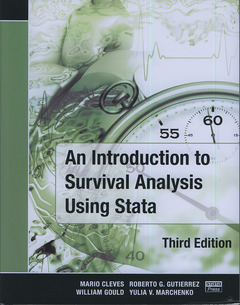An introduction to survival analysis using Stata (3rd Ed.)
Langue : Anglais
Auteur : CLEVES Mario

This book is the ideal tutorial for professional data analysts who want to learn survival analysis for the first time or who are well versed in survival analysis but are not as dexterous in using Stata to analyze survival data. It also serves as a valuable reference to those readers who already have experience using Stata's survival analysis routines. This edition has been updated for Stata 11, and it includes a new chapter on competing-risks analysis. This chapter describes the problems posed by competing events (events that impede the failure event of interest), and covers estimation of cause-specific hazards and cumulative incidence functions. Other enhancements include the handling of missing values by multiple imputation in Cox regression, a new-to-Stata-11 system for specifying categorical (factor) variables and their interactions, three additional diagnostic measures for Cox regression, and a more efficient syntax for obtaining predictions and diagnostics after Cox regression. Survival analysis is a field of its own that requires specialized data management and analysis procedures. To meet this requirement, Stata provides the st family of commands for organizing and summarizing survival data. The authors of this text are also the authors of Stata's st commands. This book provides statistical theory, step-by-step procedures for analyzing survival data, an in-depth usage guide for Stata's most widely used st commands, and a collection of tips for using Stata to analyze survival data and to present the results. This book develops from first principles the statistical concepts unique to survival data and assumes only a knowledge of basic probability and statistics and a working knowledge of Stata. The first three chapters of the text cover basic theoretical concepts: hazard functions, cumulative hazard functions, and their interpretations, survivor functions, hazard models, and a comparison of nonparametric, semiparametric, and parametric methodologies. Chapter 4 deals with censoring and truncation. The next three chapters cover the formatting, manipulation, stsetting, and error checking involved in preparing survival data for analysis using Stata's st analysis commands. Chapter 8 covers nonparametric methods, including the KaplanMeier and NelsonAalen estimators and the various nonparametric tests for the equality of survival experience. Chapters 911 discuss Cox regression and include various examples of fitting a Cox model, obtaining predictions, interpreting results, building models, model diagnostics, and regression with survey data. The next four chapters cover parametric models, which are fit using Stata's streg command. These chapters include detailed derivations of all six parametric models currently supported in Stata and methods for determining which model is appropriate, as well as information on stratification, obtaining predictions, and advanced topics such as frailty models. Chapter 16 is devoted to power and sample-size calculations for survival studies. The final chapter covers survival analysis in the presence of competing risks.
Date de parution : 10-2010
Ouvrage de 412 p.
18x23 cm
Disponible chez l'éditeur (délai d'approvisionnement : 15 jours).
Prix indicatif 70,91 €
Ajouter au panierThèmes d’An introduction to survival analysis using Stata :
© 2024 LAVOISIER S.A.S.



